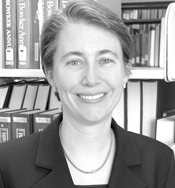Statistics in Defense and National Security: Lessons in Outreach to Policymakers
Nancy Spruill, Office of the Secretary of Defense, and Alyson Wilson, Iowa State University
For this month’s column, I’m pleased to have representatives from the ASA’s Section on Statistics in Defense and National Security (SDNS) as guest authors. Members of this section have made outreach to policymakers an integral part of their activities, with significant strides. After attending, and being impressed by, their meeting during JSM this summer, I thought it would be helpful for them to share with other ASA members their progress to date and their plans for the future. ~ Steve Pierson, ASA Director of Science Policy, pierson@amstat.orgContributing Editors
Alyson Wilson has been an associate professor of statistics at Iowa State University since 2008. She moved to ISU after nine years in the statistical sciences group at Los Alamos National Laboratory, where she developed and applied methodology to assess the reliability of conventional and nuclear weapons.
Nancy Spruill is the director of acquisition resources and analysis for the undersecretary of defense for acquisition at Technology & Logistics. A Fellow of the American Statistical Association, her honors and awards include the Defense Medal for Meritorious Civilian Service, the Hammer Award, and the Presidential Rank Award.
At JSM this summer, the Section on Statistics in Defense and National Security (SDNS) sponsored a one-day meeting that was attended by senior defense and homeland security officials. The meeting was one effort by SDNS to educate decisionmakers about how statistics and statisticians can address their challenges. It also helped educate our fellow statisticians about the many interesting and exciting opportunities in this area. We accepted the invitation to write this column to share our activities with you so you might learn from our experience, but also so we can hear and learn from you.
A brief history of the SDNS section is helpful to understand our efforts and illustrate the importance of persistent, incremental progress. Our inception can be traced, in part, to the 1984 JSM comments of former ASA President Richard Savage, who argued that statisticians should have a major role in defense issues because of the inherent uncertainty and the measurement of variability in so many of its topics. Through the support of many ASA presidents and committed ASA members, SDNS started as a committee in 1988 and became a section in 2004. Former ASA President Sallie Keller-McNulty was particularly helpful in assisting SDNS in identifying potential outreach directions through her establishment of the ASA Task Force on Defense and Security.
Keller-McNulty’s comments from the time echo themes going back to Savage and lay out a clear challenge for the ASA:
- National/international security is a problem that is growing in importance at a frightening pace, and my experience at Los Alamos National Laboratory has made me aware that statistical science is nearly invisible in this arena … ASA must provide a strong and unified voice that will make statistics an integral member of the national and international security communities.
- To answer this challenge, her task force developed a long set of recommendations, many of which are the basis for SDNS’ road map. The map is rather broad, so we’ll focus on the items most relevant to policy.
Outreach to Decisionmakers
The meeting held during JSM was planned to take advantage of JSM being in Washington, DC, and funded by a member initiative from the ASA Board of Directors. A day-long event, the morning sessions included presentations by senior officials of the Office of the Secretary of Defense, U.S. Army, Department of Homeland Security, Defense Advanced Research Projects Agency (DARPA), and Joint Warfare Analysis Center .
Nozer Singpurwalla of DARPA gave the keynote address. He focused on the historical roots of statistics in defense problems, applications of statistical approaches, and success stories.
Other presentations largely focused on the challenges the speaker’s office/organization encountered and where they thought statistics might be able to play a role. They addressed issues such as how good they are at anticipating defense needs, whether the systems they produce are better than what is already available, and what is likely to be transforming.
One speaker noted that one of his biggest problems is the data—it is usually messy and often has missing observations. We also heard about the operational point of view in a talk by a representative of the Joint Forces Command. He gave us interesting information about the analytical challenges in the joint operating environment, how the forces will be fighting in the future, and how he sees statisticians contributing to the nation’s security.
In the question-and-answer period that followed each presentation, participants asked questions and suggested ways statistics could help address the issues.
Most speakers had a basic understanding of statistics, but came away with a better appreciation for the role statistics can play. We tried to impress upon them the gap between the state of the art of statistics and what they may have picked up in a graduate statistics course 20–30 years ago. They learned about areas where their interests overlapped those of statisticians. Contact information was exchanged and follow-ups are occurring.
The afternoon session featured remarks by SDNS members on how statistics was already being used successfully on defense- and security-related problems. These presentations included work on biosurveillance, test and evaluation, and text data mining. Most presentations will be posted to the SDNS web site here.
Other activities members of SDNS have pursued in an attempt to reach out to decisionmakers include hosting meetings between ASA presidents and Department of Defense and CIA policy offices to raise the visibility of statistics. While the reception has been positive, it is important that this be an ongoing activity and that we also seek meetings with officials in the Department of Homeland Security and Department of Energy Office of Science.


















